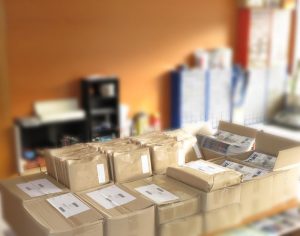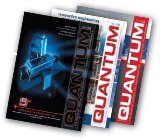Joost Backus
I was sorry to hear that Joost Backus of Bits&Chips has sadly passed away. He'd helped to grow the publication into a valued resource for engineers in the Netherlands, and was well-known in the industry. Read his obituary on the Bits&Chips website.
It's still all about getting printed magazines in the post!

Svet mehatronike has just celebrated it's first birthday and I loved the picture that publisher Jure Mikeln sent me of the most recent "shipping day". Clearly the publication is doing well, and the model of charging a nominal subscription (just 4 Euros per year to cover postage) is a strategy that readers like. I'm just glad it's not me stuffing all those envelopes!
5000 visitors to Electronics For You Expo Western India
It's good to see shows being successful, and the EFY Expo Western India, which was held in Mumbai on the 21st to 23rd November definitely exceeded expectations. The organisers expected around 1500 to 2000 visitors, so the 5010 people who came through the door to see the 57 exhibitors was a real success.
India is a really important market for many technology companies and is growing very quickly. India is maturing rapidly as a technology market, and it's now all about quality rather than quantity. So was good to see that the organisers were particularly pleased with the positive feedback from exhibitors about the quality of the visitors.
Website relaunch in Hungary
It is sometimes said that the online opportunities are limited in Eastern Europe, with publishers focusing more on print titles, but this is no longer the case in most countries. One example is hungry where ELEKTROnet has redesigned their website with a new simplified layout that can compete with some of the best layouts in Europe. With Eastern Europe continuing to grow in importance for many companies in the electronics sector, it's great to see publishers in this region investing in their websites.
National Electronics Week South Africa has a new venue for 2014
New Events Ltd has announced that National Electronics Week South Africa 2014 will be held on 11th – 12th March 2014 at a new venue: the Gallagher Estates in Midrand is located between Johannesburg and Pretoria and has great access by road, rail and air. If you're thinking of exhibiting and are a british company, there is also support and funding for UK companies via UKTI. New Events are also busy at home in the UK as the South West Electronics Expo will be held from 25th to 26th September 2014 at the University of West England, Bristol.
Electronics event for Western India

Mesago PCIM GmbH switches from i2i to Messe Frankfurt China for PCIM Asia
Mesago PCIM GmbH has decided to change partners for the PCIM Asia event. They will work with Messe Frankfurt China, organisers of the SPS Industrial Automation Fair Guangzhou, rather than i2i. This puts the power of two major exhibition companies behind PCIM Asia, and should help the event grow and develop.
In turn, i2i has plans to launch a number of local shows, sponsored by Bodo's Power China and supported by Chinese Universities. These Power Electronics summits will be held in Suzhou, Harbin, Xian and Chengdu.
Elektroniktidningen enters joint venture to launch Finnish electronics publication

This is fabulous news. The Finnish electronics market is so much more than just Nokia: in fact it has one of the most dynamic start-up scenes in Europe (not just Angry Birds!). There is a real market for a Finnish publication, and it was a real shame that a high-quality publication such as Prosessori had to close. So it was especially nice to hear the promise that Elektroniikkalehti will, "pick up where Prosessori left off."
Elektroniikkalehti is already up and running. The website is www.elektroniikkalehti.fi or you can use the shortcut www.etn.fi.
Electropages adds in-app newsletters
Users of the Electropages app who subscribe the the email newsletter can now choose to have it sent via an alert directly to their handset or tablet. This isn't just a "nice-to-have" feature: Electropage's early research suggests that this delivery method increases page views: a finding that matches other research showing engagement to be much higher if read on either a tablet or a Smart Phone. We understand that there are plans to offer users the option to only receive product news / companies which are relevant to them. An Android version is planned for the Autumn, and Electropages will also roll out localised versions for China, Asia, Germany and Brazil by the end of this year.
Indian shows increase space
The organisers of electronica India and productronica India, which will take place at Pragati Maidan, New Dehli from 4th to 6th September 2013, have announced that they've increased exhibition space to 15,000 square meters. Whilst it's obviously easier to grow events in a dynamic market such as India, it's great to see such a successful show.
New video - how to brief your agency
Want to get the best out of your agency? Improving your campaign briefs is one great way of getting other results. If your agency isn't helping you improve your briefs, then why not have a look at this short video we've produced to help our clients clearly explain the results they expect from campaigns we run.
View more of our videos on the Napier YouTube Channel.
Call for papers: SAME 2013
The organisers of SAME 2013 have issued a call for papers focused on Applications of Sensor Technology, which can cover example applications, systems, IC development, firmware or software. Abstracts must be submitted by 15th May 2013, with final deadlines for the paper and slides 20th June and 20th July respectively. Submission instructions and a template for the abstract are available on the SAME website.
Smart Systems Integration reports same strong attendance as 2012
The organisers of rel="nofollow"Smart Systems Integration have announced that this year's event achieved the same strong levels of attendance as last year. They've also posted some images from the event online.
Technologies magazine to close at end of March
Sad news: Technologies, the popular Israeli title, is to close at the end of the month. The publisher, K.D.C Technologies Ltd made the decision to cease trading at the beginning of the week. There is some speculation that the brand might be purchased, or that the editorial team might start up a new title: we will let you know if there is any announcement.
New French Online Publication, L'Embarqué, Launches
It may surprise some people - George Bush amongst them - that when it comes to the IT press, France has the most entrepreneurial journalists in Europe. The media landscape is dominated by blogs and online publications run by the journalists who edit them. So I was delighted to hear that the same is beginning to happen in the electronics sector. Pierrick Arlot and François Gauthier have announced the launch of a new online publication, L'Embarqué ("The Embedded"), with a website; daily and weekly email newsletters and a quarterly digital magazine. They're not only informing French engineers, as they will also publish an English language email newsletter that will update readers on news related to the French embedded market. The publication will cover news related to embedded hardware and software technology, as well as including market research and issues related to working in the embedded market.
This is great news. In B2B trade media, it's becoming harder for large publishing companies with their unavoidable overheads, to be profitable. Either publishers need to offer a much broader range of services, or the model need to change. Whilst it's not easy for journalists to start their own publications, when it works a higher percentage of the income ends up with the journalists that create the value. This has to be a good thing. And France is suffering from a lack of electronics publications: there's no possibility that this new title will lead to an overcrowded market!
I wish Pierrick and François the very best of luck with L'Embarqué and hope this new title goes from strength to strength.
Dataweek invests in online and launches mobile website
It's not all doom and gloom in South Africa. Although Quantum has closed, Dataweek continues to be successful, and has just launched an updated website. Engineers will like the ease of use and the more frequent updates to home page content, whilst advertisers will appreciate the tweaks to make their advertising more effective.
In addition to the desktop site, there's now a mobile version, which is also accessible from the main www.dataweek.co.za URL.
It's good to see that Dataweek is not only continuing to do well, but that the publishers, Technews are continuing to invest in the product. I hope this investment is rewarded with more advertising.
Fine Street adds control title to its portfolio
Fine Street has added Control Engineering Russia to it's portfolio, a great move that complements it's existing publications, including Components and Technologies.
Electropages to launch Chinese site

India gets first electronics test and measurement event
Electronics for You Expo has announced that they will be running T&M India - the first show for electronics test and measurement products and services in India. The exhibitor list already includes big-brand names such as Agilient, Lecroy, Megger, National Instruments and Rhode Schwarz, so the event certainly has the right exhibitors to attract high-quality visitors.
It's funny that this is the first T&M show in India - we've seen a significant interest in our clients' activities in India and so it's easy to assume that the country already has events to cater for all aspects of the industry. But the truth is that the country is growing so fast that some of the marketing infrastructure is still catching up. The local events and publications are developing rapidly, and it's clear that, over the next few years, India is will continue to be one of the most exciting countries for the electronics industry.
Quantum ceases publication with immediate effect

Huson takes over French titles as Francois Krebel retires
Francois Krebel built a reputation as being one of the "good guys" of the electronics media in Europe, and has just announced he is retiring. At Napier we had a great time working with him and wish him all the best for his well-deserved retirement. We're also really pleased that Huson Media has picked up the French titles he represented – they also do a great job for the media they represent.
Will Google really stop linking to French online publications?
The French are getting excited over the threat from Google to stop linking to French media websites in protest against legislation that would force search engines to pay for content. I think this is a good thing: Google has the power and influence to stop laws that prevent reasonable sharing of links, and publications must understand that links are the heart that pump traffic to their sites.
But what about the UK? The law has allowed the NLA to force businesses that share links to newspapers to pay licence fees. So where is the protest from Google over here? Well it appears that because Google has negotiated an exemption, they're quite happy to forget the protests. Google is a search engine, so they're fine, but media monitoring companies – who have software engines that search for content, so are hardly that different – are not. Perhaps "Don't be evil" got replaced with "I'm alright, Jack" in the UK.
DATE attracts over 1000 submissions
DATE 2013 has achieved a real milestone by attracting over 1000 submissions for the conference. This is a stunning result, and shows how challenging it can be to secure a speaking slot at an event.
Although it will be held in Grenoble, France in 2013, DATE continues to have international appeal, with the Americas and Asia-Pacific accounting for 30% and 19% of the submissions.
Competitions with prizes made easier in France
After the European Court ruled on 14 January 2010 that "a local law cannot prohibit, whatever are the circumstances, commercial practices consisting in making the entrance to a prize draw conditional on the prior purchase of a good or service, even if it is to ensure a higher level of protection of the consumer", France has finally relaxed their laws relating to promotions that offer a chance of winning a prize. I'm not a lawyer, so I strongly recommend reading the article about the changes in French law on the Marketing Law blog.
New white paper–Email Marketing Success
We've conducted several research studies in partnership with the University of Chichester to understand how to create more effective email marketing campaigns. Our Email Marketing Success 2012 white paper reveals several surprising facts about engineers and email marketing: 80% of engineers find less than 20% of the marketing emails they receive to be useful, they don't want company news and the sender is by far the biggest factor in determining whether an engineer opens an email. The white paper is available free of charge, so download Email Marketing Success 2012 now!
Sorry this white paper is no longer available. Contact Napier for the latest email marketing research.

